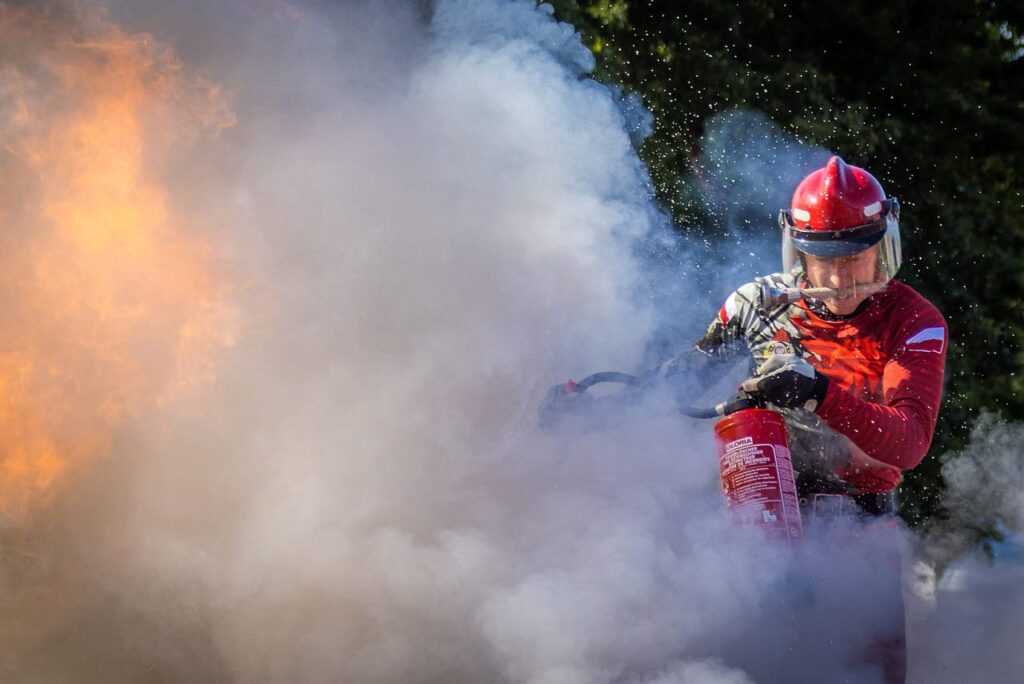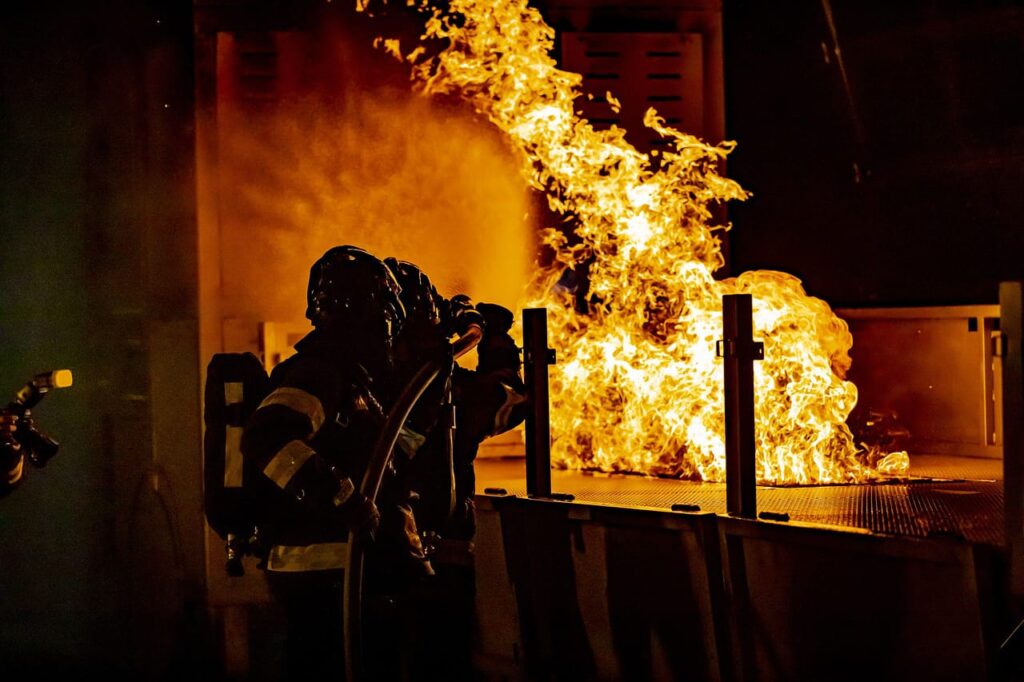A fire Extinguisher is a defensible device that discharges a jet of foam, gas, or water. A Fire Extinguisher is a handheld active fire protection element. It filled up dry or wet chemicals to control small fires. Fire extinguishers can save a life or a vital marriage when burning. So, you should know how to use a Fire Extinguisher if a fire develops. However, it is not for use in an out-of-control fire; otherwise, it requires the skills of a fire brigade. Moreover, you should know how to use it.
There are four basic steps of it.
- Pull Pin
- A pin at the top of the fire extinguisher breaks the seal. By pulling the pin, the operating lever should unlock. Then, you will be allowed to discharge the fire extinguisher.
- Aim Low
- Aim the nozzle towards the base of the fire. Mainly, point the extinguisher hose at the base of the fire.
- Squeeze
- Squeeze the handles together and
- Discharge the extinguisher agent inside. To stop, release the handle.
- Sweep
- Sweep the nozzle from side to side and direct the fire extinguishing agent at the base of the flames. If the fire reignites, repeat the process.
Have a fire extinguisher in your kitchen.
Learn to Use a Fire Extinguisher
A fire extinguisher is a common and useful tool against fires. There are so many common ones that you probably walked past one as you headed to work today.
You probably don’t know how to use it, No matter how many times a day you pass by the fire extinguisher in your office.
Not knowing how to use a fire extinguisher, When it comes to fire can cost you a lot. Remember, you can’t be fumbling around during emergencies.
Before learning how to use a fire extinguish of fire extinguisher, one must know the different kinds of extinguishers based on the fires can be put out:
Class A: solid combustibles like paper and wood. Class fires are fueled every day.
B: gas and – and fuel-based firesClass
C: this fire was caused by electricityClass
D: fires fueled by flammable metals class
K: used to extinguish oil and grease fires
Using a fire extinguisher takes only minutes to learn and is pretty straightforward.
How Do Fire Extinguishers Work?
Fire extinguishers are essential equipment that can help protect you and Damage or reduce any further risk of harm during a fire. They are required by law in most business premises. Different types of extinguishers are used for various types of fire, and they each work in different ways.
Water extinguishers
Water extinguishers are pressurized propellant gases, like nitrogen, containing only water. The water removes heat, so the fuel can no longer support combustion.
On a water extinguisher like, there’s a pin on the handle that stops the Extinguisher from being set off by mistake; the others are listed below; it’s a sign that the Extinguisher needs to be checked by an extinguisher technician; if it’s missing, or the tamper seal is broken. Once the handle is pressed, the pin is pulled from the Extinguisher; the pressurized gas pushes the water downward into the siphon tube, which runs from the top to the bottom of the Extinguisher and into the discharge hose.
Water extinguishers are only effective in Class A fires; they are not suitable for fires involving flammable liquids or electrical risks.
Carbon dioxide extinguishers
high-pressure carbon dioxide (CO2) extinguishers contain .by displacing the oxygen from it and replacing it with the inert CO2 gas. This can suffocate the fire.
A carbon dioxide extinguisher has a cone-shaped nozzle, which is much larger than that of other extinguishers. This allows the CO2 gas to spread once it’s released and expanded.
While the operator is in a confined space, Carbon dioxide shouldn’t be used – there is a risk of asphyxiation because it displaces oxygen. After using a carbon dioxide extinguisher, they don’t remove the heat from the fuel to any great extent. It’s also essential to ensure that the fire does not reignite.
Where there is electrical equipment, as the gas is a non-conductor, these extinguishers are usually sited in areas. They are also effective on smaller, flammable liquid fires.
Foam extinguishers
Foam extinguishers contain a foaming agent that smothers and slightly cools the burning substance. Like the water extinguisher, they also use compressed gas as the fuel.
There are various types of foam extinguishers. Some are general-purpose, and others are specialized and designed for cooking, such as oil fires. They are designed to be safe from electrical risks.
Dry powder extinguishers
with a compressed gas propellant, Dry powder extinguishers contain a fire-suppressing chemical powder. The powder may also smother and interfere with the combustion chain.
They have high fire ratings and purpose but should not be used in confined spaces. Near delicate electronic equipment: The powder can also be corrosive, so it should not be used.
How to Tell if Your Fire Extinguisher Has Expired:
In several years, It can be hard to know when a fire extinguisher has ‘expired’ given those that are well maintained can last up to. But most models come without a precise expiry date.
Few know when this kind of equipment was purchased or how long it has been present within a building.
When was the fire extinguisher last serviced?
The first thing to look for is the condition of the fire extinguisher itself. Check the service label to see if it has been serviced at the correct intervals, which in most cases will be annually. Rust, Damage, and corrosion are indicators that the unit has expired and should be replaced.
How old is the fire extinguisher?
It can be hard to know exactly when a fire extinguisher was installed in your building, but you should be able to see the manufacturing date stamped on the body or written on the service label.
The manufacture date will be determined if the fire extinguisher requires extended service.
If your fire extinguisher is either water, powder, or foam, it is due 5 years after first commissioning. After 10 years, if it is a CO2 extinguisher, it is due.
Is the fire extinguisher outdated?
In older buildings, Some fire extinguishers may still need to be remembered. Some older ones may not meet current standards since fire extinguishers have evolved,
and parts are no longer available and should be replaced. Fire extinguishers can no longer be serviced according to the manufacturer’s specifications.
You may well be offered a new one instead. Many extinguishers are no longer economical to test and recharge at the 5-year Extended Service intervals.
Please seek advice from an expert. If you are concerned about any fire extinguishers in your building or on your premises, our free fire surveys will offer you advice and guidance on fire safety.
There are specific problems promptly: –
In summary, if your fire extinguisher is expired, make sure to consider factors such as service history, age, and outdated technology.
The handle is broken: The maintenance record isn’t current, and The pressure gauge needle is in the red zone •. The nozzle has become blocked, and the security seal is broken; the head cap locking pin is missing or


